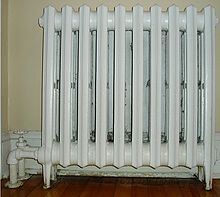This article needs additional citations for verification. (February 2017) |


Radiators and convectors are heat exchangers designed to transfer thermal energy from one medium to another for the purpose of space heating.
Denison Olmsted of New Haven, Connecticut, appears to have been the earliest person to use the term 'radiator' to mean a heating appliance in an 1834 patent for a stove with a heat exchanger which then radiated heat. In the patent he wrote that his invention was "a peculiar kind of apparatus, which I call a radiator".[1] The heating radiator was invented by Franz San Galli in 1855, a Kingdom of Prussia-born Russian businessman living in St. Petersburg.[2][3] In the late 1800s, companies, such as the American Radiator Company, promoted cast iron radiators over previous fabricated steel designs in order to lower costs and expand the market.
- ^ Kay, Thornton (14 March 2016). "A peculiar kind of apparatus, which I call a radiator". SalvoNEWS. Archived from the original on 23 December 2016. Retrieved 22 December 2016.
- ^ Family Sangalli / San Galli
- ^ Johnny Acton; Tania Adams; Matt Packer (2006). Origin of Everyday Things. Sterling Publishing Company, Inc. p. 205. ISBN 1402743025. Retrieved February 4, 2015.
radiator 1855 invented.